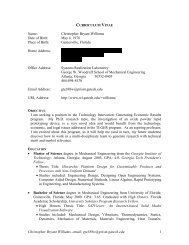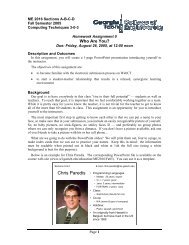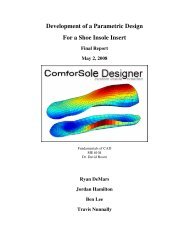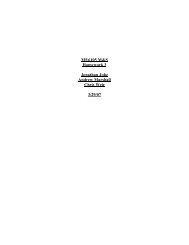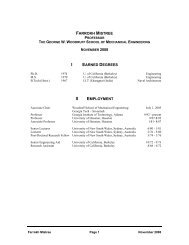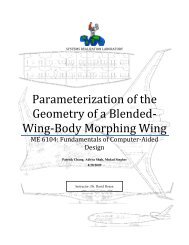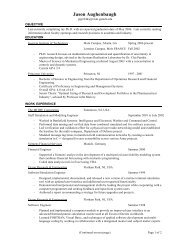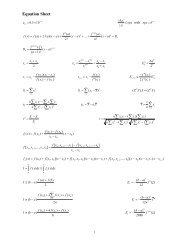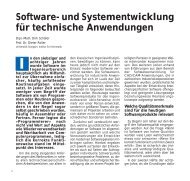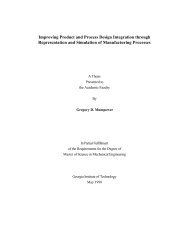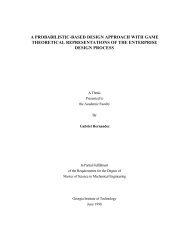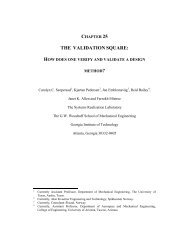An Activity-Based Life-Cycle Assessment Method - the Systems ...
An Activity-Based Life-Cycle Assessment Method - the Systems ...
An Activity-Based Life-Cycle Assessment Method - the Systems ...
You also want an ePaper? Increase the reach of your titles
YUMPU automatically turns print PDFs into web optimized ePapers that Google loves.
Proceedings of DETC’97:<br />
1997 ASME Design Engineering Technical Conferences<br />
September 14 - 17, 1997 - Sacramento, California<br />
DETC97/DFM-4376<br />
AN ACTIVITY-BASED LIFE-CYCLE ASSESSMENT METHOD<br />
Jan Emblemsvåg<br />
Graduate Research Assistant,<br />
Norwegian Research Council and<br />
Fulbright Fellow<br />
ABSTRACT<br />
In this paper, a new activity-based method for <strong>the</strong> concurrent<br />
assessment and tracing of costs, energy consumption and waste<br />
generation for usage in <strong>Life</strong>-<strong>Cycle</strong> Design is presented. The<br />
method is based on <strong>Activity</strong>-<strong>Based</strong> Costing (ABC). By<br />
utilizing ABC we are able to assess and trace accurately<br />
overhead - and direct costs, energy and waste generation.. The<br />
inherent uncertainty is modeled in terms of fuzzy numbers, but<br />
solved numerically using <strong>the</strong> Monte Carlo simulation<br />
technique, which allows us to perform a sensitivity analysis.<br />
This enables us to not only estimate <strong>the</strong> costs, energy<br />
consumption and waste generation, but also trace <strong>the</strong> largest<br />
contributors. The capability to trace <strong>the</strong> contributors is perhaps<br />
<strong>the</strong> most significant feature - especially when <strong>the</strong> method is<br />
employed for design. To illustrate <strong>the</strong> usage of this method, a<br />
simple case study is provided in which we explore <strong>the</strong> life-span<br />
costs, energy consumption and waste generation of a oil/gas<br />
exploration platofrm supply vessel operating in <strong>the</strong> North Sea.<br />
KEYWORDS: <strong>Activity</strong>-<strong>Based</strong> Costing, <strong>Life</strong>-<strong>Cycle</strong> Design,<br />
Uncertainty, Monte Carlo Simulation and Sensitivity <strong>An</strong>alysis.<br />
NOMENCLATURE<br />
<strong>Activity</strong> driver: A measure of <strong>the</strong> consumption of an<br />
activity by <strong>the</strong> assessment objects.<br />
<strong>Assessment</strong> object: <strong>An</strong>y customer, service, project or<br />
product (design) for which separate cost and revenue and/or<br />
energy consumption and/or waste generation assessments are<br />
needed.<br />
Cost consumption intensity: Unit-price of a cost driver<br />
(Cooper 1990). E.g. USD per direct labor hour.<br />
Cost driver: <strong>An</strong>y factor that causes a change in <strong>the</strong> cost of<br />
an activity (Brinker 1997). Direct labor is an example of a cost<br />
driver. In conventional costing systems, only unit-level ‘cost<br />
drivers’ are found and <strong>the</strong>se are called allocation bases. We<br />
use cost drivers as a collective term.<br />
Cost element: Amount paid for a resource consumed by an<br />
activity; it is included in a cost pool (Brinker 1997).<br />
Cost pool: A specified grouping of cost elements. For<br />
example, in (Brinker 1997) an activity cost pool is defined as a<br />
grouping of all cost elements associated with an activity.<br />
Energy consumption intensity: Unit-energy<br />
consumption of an energy driver. For example Joule per<br />
machine hour.<br />
Bert Bras<br />
Assistant Professor<br />
<strong>Systems</strong> Realization Laboratory<br />
The George W. Woodruff School of Mechanical Engineering<br />
Georgia Institute of Technology<br />
Atlanta, GA, 30332<br />
USA<br />
Energy driver: <strong>An</strong>y factor that causes a change in <strong>the</strong> energy<br />
consumption of an activity.<br />
Resource element: <strong>An</strong> economic, energy related or waste<br />
related element that is used in <strong>the</strong> performance of activities.<br />
Resource driver: A measure of <strong>the</strong> quantity of resources<br />
consumed by an activity, e.g. <strong>the</strong> percentage of total square feet<br />
of space occupied by an activity (Brinker 1997).<br />
Resource pool: A specified grouping of resource elements.<br />
For example, an activity resource pool is defined as a grouping<br />
of all resource elements associated with an activity.<br />
Waste generation intensity: Unit-waste generation of a<br />
waste driver (an extension of cost consumption intensity into<br />
waste generation). For example Waste Units per welding hour.<br />
Waste driver: <strong>An</strong>y factor that causes a change in <strong>the</strong> waste<br />
generation of an activity (see Waste element).<br />
Waste element: <strong>An</strong> element of waste generated in <strong>the</strong><br />
consumption of activities, e.g., fuel consumption is a waste<br />
driver and CO 2, CO, SO 2 and NO X are <strong>the</strong> waste elements.<br />
Waste pool: A specified grouping of waste elements. For<br />
example, an activity cost pool is defined as a grouping of all<br />
waste elements associated with an activity.<br />
1 . 0 OUR FRAME OF REFERENCE<br />
1 . 1 Motivation<br />
It is generally agreed that environmental considerations<br />
must cover a product’s entire life-cycle and that a holistic,<br />
systems-based view provides <strong>the</strong> largest capability for reducing<br />
environmental impact of both products and associated processes.<br />
The environmental aspect of product life-cycles has become<br />
more and more important in recent years as our environment is<br />
deteriorating. To turn around this negative development, we<br />
must produce goods and services in a sustainable fashion.<br />
Already, in <strong>the</strong> U.S., a lot of attention is being given to<br />
Pollution Prevention and minimization of waste.<br />
Managing energy consumption, however, is just as<br />
important for good pollution (waste) control as managing<br />
pollutants (waste). Energy is one of <strong>the</strong> driving forces in socioeconomic<br />
development (Olsson 1994) and on a worldwide basis,<br />
1 Copyright © 1997 by ASME
energy constitutes 57% 1 of all CO 2 emissions into <strong>the</strong><br />
atmosphere (Fowler 1990).<br />
The most comprehensive tools to be used to analyze <strong>the</strong><br />
environmental impact of products are <strong>the</strong> so-called eco-balances<br />
and life cycle analyses/assessments (LCA). LCA is a method in<br />
which energy and raw material consumption, different types of<br />
emissions and o<strong>the</strong>r important factors related to a specific<br />
product are measured, analyzed and summoned over <strong>the</strong> entire<br />
life-cycle from an environmental point of view. The strength of<br />
LCA is <strong>the</strong> (potential) broadness of scope and depth of<br />
evaluation. However, designers find it almost impossible to<br />
practically work with LCAs, because <strong>the</strong> tools have a tendency<br />
to be as complex as <strong>the</strong> issue under investigation. Also, <strong>the</strong><br />
LCA methods have not (yet) been fully standardized and a<br />
number of different weighting and assessment schemes exist<br />
which may cause ambiguity. Fur<strong>the</strong>rmore, LCAs do not<br />
capture <strong>the</strong> traditional way of management using economic<br />
indicators.<br />
1 . 2 Our Combined Environmental and<br />
Economical <strong>Assessment</strong> <strong>Method</strong> <strong>Based</strong> on ABC<br />
In our opinion, a life-cycle assessment method should<br />
capture both <strong>the</strong> environmental and economic impact of a<br />
product to provide <strong>the</strong> most useful feedback to designers,<br />
engineers, and managers. In order to achieve such an integrated<br />
economical and ecological assessment approach, we believe that<br />
<strong>the</strong> use of an <strong>Activity</strong>-<strong>Based</strong> Costing approach may overcomes<br />
some of <strong>the</strong> difficulties associated with conventional LCA<br />
tools, e.g., <strong>the</strong> cumbersome amount of work involved, <strong>the</strong><br />
usage of non-comparable units and <strong>the</strong> lack of common<br />
standards. Our goal is to model all <strong>the</strong> aspects of product<br />
realization along with <strong>the</strong> associated economical transactions for<br />
<strong>the</strong> entire life-cycle. The foundation for this work has been<br />
presented in e.g. (Bras and Emblemsvåg 1996). In this paper,<br />
we build upon <strong>the</strong> previous work and show specifically <strong>the</strong><br />
following:<br />
• How our new ABC based method can be used not only for<br />
life-cycle costing (as it was intended/invented for), but also<br />
for life-cycle assessments (LCAs) of environmental impact<br />
in terms of<br />
1. waste generation and<br />
2. energy consumption.<br />
• <strong>An</strong> example of how <strong>the</strong> method can be implemented using<br />
an UT 705 Platform Supply Vessel (PSV) is presented.<br />
This specific type of PSVs was designed by Ulstein<br />
International AS in Norway. The vessel is capable of:<br />
1. Transporting pipes, cement, equipment and goods to<br />
and from pipeline barges, oil rigs and ships.<br />
2. Loading and laying beside a pipeline barge under<br />
North Sea conditions with approximately 4.6 meter<br />
high waves and a tidal current of roughly 3.5 knots.<br />
As mentioned earlier, we assume three aspects of product<br />
realization in this paper; 1) costs and revenues, 2) energy<br />
consumption, and 3) waste generation. In <strong>the</strong> following three<br />
sections we will discuss <strong>the</strong>se three aspects.<br />
2 . 0 ACTIVITY-BASED COSTING<br />
2 . 1 Motivation for <strong>Activity</strong>-<strong>Based</strong> Costing<br />
The strength of <strong>Activity</strong>-<strong>Based</strong> Costing with Uncertainty<br />
(referred to as ACU) described in (Emblemsvåg and Bras 1994;<br />
1 This number was calculated by <strong>the</strong> U.S. Environmental Protection Agency<br />
and applies to <strong>the</strong> USA. The actual figure may vary from country to country<br />
depending on its energy mix.<br />
Bras and Emblemsvåg 1996) is <strong>the</strong> combination of <strong>Activity</strong>-<br />
<strong>Based</strong> Costing (ABC) and <strong>the</strong> modeling of uncertainty as<br />
continuous and discrete probability distribution. The usage of<br />
ABC is gaining more and more ground on conventional costing<br />
systems (Cooper 1990; Keoleian and Menerey 1994) - initially<br />
due to more correct cost assessments but more lately due to <strong>the</strong><br />
improved capability of tracing <strong>the</strong> costs. This tracing capability<br />
is enhanced in our method by <strong>the</strong> usage of uncertainty and<br />
sensitivity analysis. The two key differences between ABC and<br />
conventional costing systems are as follows:<br />
• In an ABC system it is assumed that a cost object consumes<br />
activities, while in a conventional system it is assumed that<br />
a cost object consumes resources.<br />
• <strong>An</strong> ABC system utilizes cost drivers at several levels (unit-,<br />
batch-, product- and factory level), while a conventional<br />
system uses only unit level characterizations, called<br />
allocation bases. <strong>An</strong> allocation base corresponds to a unitlevel<br />
cost driver.<br />
Because of <strong>the</strong>se differences, ABC can handle overhead costs far<br />
better than conventional costing systems, and since <strong>the</strong> portion<br />
of overhead costs is increasing in most industries - <strong>the</strong> focus on<br />
overhead costs is also increasing. For in-depth discussions of<br />
ABC see (Cooper 1990; O'Guin 1990; Raffish and Turney<br />
1991; Turney 1991) A motivating example for use in an<br />
environmental context is found in (Brooks, Davidson et al.<br />
1993). For <strong>the</strong> same reasons that an activity-based costing<br />
method is preferred to a conventional costing method, activitybased<br />
methods for handling energy consumption and waste<br />
generation are, in our opinion, also better than more<br />
conventional methods.<br />
2 . 2 Inclusion of Uncertainty<br />
One of <strong>the</strong> challenges of design is <strong>the</strong> ‘inherent<br />
uncertainty’. There are simply no ways of discarding <strong>the</strong><br />
uncertainty in design; we must <strong>the</strong>refore include it. In our<br />
method, <strong>the</strong> uncertainty is handled by modeling <strong>the</strong> uncertainty<br />
as fuzzy numbers which has two advantages:<br />
• Fuzzy numbers can be used with or without hard data.<br />
Ordinary statistics, however, needs quite a large sample of<br />
hard data. It goes without saying that <strong>the</strong> more relevant hard<br />
data, <strong>the</strong> better.<br />
• The usage of fuzzy numbers allows us to customize<br />
uncertainty distributions ( e.g. you can cut off a normal<br />
distribution anywhere you like). This is not possible in<br />
ordinary statistics.<br />
The Monte Carlo simulation technique is employed to solve <strong>the</strong><br />
model and to find numerically how <strong>the</strong> assumption cells (where<br />
<strong>the</strong> fuzzy numbers are modeled) affect <strong>the</strong> forecast cells. This<br />
simulation is performed by <strong>the</strong> Crystal Ball ® software, which is<br />
an extension on top of Microsoft Excel ® software. For more<br />
information regarding how to include uncertainty see<br />
(Emblemsvåg and Bras 1994; Bras and Emblemsvåg 1996).<br />
3 . 0 ACTIVITY-BASED ENERGY<br />
CONSUMPTION ASSESSMENTS<br />
It is very simple to modify <strong>the</strong> ACU method and create an<br />
<strong>Activity</strong>-<strong>Based</strong> Energy Consumption method. Ra<strong>the</strong>r than<br />
speaking about cost drivers and cost consumption intensities,<br />
we can introduce energy drivers (see Nomenclature) and<br />
associated energy consumption intensities to perform energy<br />
assessments. The use of energy drivers is identical to <strong>the</strong> use of<br />
cost drivers. The reason we can do this is that a) energy can be<br />
measured in terms of Joules [J] just as costs can be measured in<br />
terms of [$] and b) energy - like costs - is incurred as a result of<br />
2 Copyright © 1997 by ASME
an assessment object’s consumption of activities. The<br />
uncertainty is handled identically as for <strong>the</strong> costing model.<br />
4 . 0 ACTIVITY-BASED WASTE GENERATION<br />
ASSESSMENTS<br />
<strong>An</strong>alogous to cost and energy drivers, we can define a waste<br />
driver (see Nomenclature). However, <strong>the</strong>re is no obvious single<br />
value or clear unit as for energy (Joules) or cost (dollars) that<br />
can be used as a waste generation intensity (see Nomenclature)<br />
associated with a waste driver because <strong>the</strong>re are many different<br />
materials, and <strong>the</strong>re are many different ways <strong>the</strong>se materials<br />
affect <strong>the</strong> environment. Hence, a single valued index for<br />
assessing <strong>the</strong> “cost” or impact of various materials needs to be<br />
defined to make our method capable of an activity-based waste<br />
assessment. Once a waste driver and <strong>the</strong> associated waste<br />
generation intensity - represented by <strong>the</strong> single valued waste<br />
index - are established, <strong>the</strong> very same activity-based approach<br />
can be applied. However, what is an appropriate index? In <strong>the</strong><br />
following sections, we present a short discussion on existing<br />
indices (Section 4.1) and we present a recently developed index<br />
(section 4.2).<br />
4 . 1 Short Discussion on Indicators<br />
In <strong>the</strong> literature <strong>the</strong>re are many different indices and<br />
indicators presented, but as thoroughly discussed in (Ayres<br />
1995) <strong>the</strong>y suffer from two serious problems:<br />
1) Data deficiency, i.e. as a lot of data is missing, because it is<br />
a new field, This is a problem for all analyses that deal with<br />
energy and waste assessments. Our new index (see Section<br />
4.2) has <strong>the</strong> same problem, which will be evident from <strong>the</strong><br />
example presented in this paper. However, this problem<br />
will generally disappear as more case studies and data<br />
become available. Already we see more case study material<br />
from LCAs become publicly available, increasing <strong>the</strong><br />
amount of data one can draw upon.<br />
2) The usage of non-comparable units of measurement makes it<br />
impossible to compare <strong>the</strong> results from one analysis to <strong>the</strong><br />
results from ano<strong>the</strong>r analysis. <strong>An</strong> example of this is <strong>the</strong><br />
Eco-Indicator used in <strong>the</strong> SimaPro software from Pré<br />
Consultants. The problem is that <strong>the</strong> weights and criteria<br />
used are questionable, thus leaving a lot of unanswered<br />
questions and political debate.<br />
Especially <strong>the</strong> (political) issue of weighting <strong>the</strong> different noncomparable<br />
units has led us to develop a new index that uses<br />
comparable units of measurement. It should be noted that our<br />
activity-based approach works with any single-numbered index<br />
or indicator.<br />
4 . 2 A New Waste Index<br />
In developing our new Waste Index, we used <strong>the</strong> following<br />
basic assumption:<br />
<strong>An</strong>y substance in a sufficient amount beyond its natural<br />
amount in a specified control volume (environment)<br />
can be considered waste (pollution).<br />
With ‘Waste’ and ‘Control Volume’ we mean <strong>the</strong> following:<br />
• ‘Waste’ is all unwanted material created by <strong>the</strong> consumption<br />
of an activity. The material may be any of <strong>the</strong> following<br />
types (radioactive or not): biological entities or tissue,<br />
solids, liquids and/or gases.<br />
• The ‘Control Volume’ is <strong>the</strong> geographical area of <strong>the</strong><br />
environment affected ei<strong>the</strong>r by <strong>the</strong> generated waste directly or<br />
by <strong>the</strong> substances <strong>the</strong> generated waste is decomposing into.<br />
We define our Waste Index (WI) as follows:<br />
WI CV ⎛ Waste R⋅T ⎞ ⎛<br />
N R⋅T ⎞<br />
= ⋅⎜<br />
⎟= C⋅⎜ ⎟<br />
CV ⎝ A ⎠ ⎝ A ⎠<br />
System<br />
N<br />
The parameters that determine <strong>the</strong> Waste Index (WI) are:<br />
1. Natural amount A N [kg] of <strong>the</strong> generated waste or<br />
substances into which <strong>the</strong> generated waste would<br />
decompose in <strong>the</strong> specified control volume. Important<br />
tools in this context are chemical mass balance equations<br />
and <strong>the</strong>rmodynamics, as pointed out in (Ayres 1995) as<br />
well. If <strong>the</strong> generated waste (or <strong>the</strong> substances <strong>the</strong> generated<br />
waste will decompose into) does not occur naturally in <strong>the</strong><br />
control volume, <strong>the</strong>n AN is set to one (1).<br />
2. Released amount of <strong>the</strong> generated waste - R [kg/h]. If <strong>the</strong><br />
released amount is of no or negligible importance <strong>the</strong> value<br />
is set to one (1), e.g. in <strong>the</strong> case of corrosion of iron where<br />
<strong>the</strong> amount of iron is almost irrelevant.<br />
3. Estimated time <strong>the</strong> release will af fect <strong>the</strong> control volume -<br />
T N [h]. This time is measured from <strong>the</strong> very first emission<br />
to <strong>the</strong> time when <strong>the</strong> effect of <strong>the</strong> emissions is gone - that<br />
is, <strong>the</strong> time <strong>the</strong> control volume needs to achieve balance<br />
again. In cases where <strong>the</strong> generated waste is not degradable<br />
<strong>the</strong> TN is set to one (1). This special case is rare.<br />
4. Control volume ratio - C [-]. Obviously, <strong>the</strong> different<br />
parameters must be estimated in <strong>the</strong> same control volume.<br />
Thus, for a complex system <strong>the</strong> largest control volume<br />
encountered will be <strong>the</strong> determining control volume. We<br />
<strong>the</strong>refore scale <strong>the</strong> different control volumes by dividing <strong>the</strong><br />
volume of <strong>the</strong> largest control volume for <strong>the</strong> generated<br />
waste element ( CVWaste ) by <strong>the</strong> volume for <strong>the</strong> control<br />
volume for <strong>the</strong> entire system ( CVSystem ) (see equation 1).<br />
The notion of control volumes is extremely important<br />
because it allows us to quantify continuously <strong>the</strong><br />
importance of <strong>the</strong> geographical areas of impact. In many<br />
LCAs <strong>the</strong> only distinction is between ‘local’, ‘regional’ and<br />
‘global’ impact areas. This discrete qualitative method is<br />
too crude and ambiguous, and it increases <strong>the</strong> problem of<br />
non-comparable studies, in our opinion.<br />
Ideally, <strong>the</strong> Waste Index (WI) should approach zero and <strong>the</strong><br />
larger <strong>the</strong> index, <strong>the</strong> more out of balance <strong>the</strong> control volume is<br />
brought by <strong>the</strong> product . Fur<strong>the</strong>rmore, one unit of <strong>the</strong> Waste<br />
Index is for simplicity denoted Waste Unit (WU) because <strong>the</strong><br />
waste index is dimensionless.<br />
The reason for choosing one (1) as default values for AN, R<br />
and TN is to remove <strong>the</strong> effect of <strong>the</strong> parameter from <strong>the</strong> index.<br />
This is an important feature of <strong>the</strong> index because it allows us to<br />
handle special cases as well as <strong>the</strong> more common situations<br />
where all parameters are used. E.g., if we release iron to a river,<br />
we can assume that <strong>the</strong> degradation process for <strong>the</strong> iron will be<br />
corrosion. Due to <strong>the</strong> fact that <strong>the</strong> corrosion speed of iron is<br />
almost independent of <strong>the</strong> quantity we set R to 1 kg/h. The<br />
value of <strong>the</strong> index will <strong>the</strong>refore only depend of <strong>the</strong> geographical<br />
area (control volume), <strong>the</strong> corrosion speed and <strong>the</strong> natural<br />
amount of iron in <strong>the</strong> riverbed.<br />
If one wants to estimate <strong>the</strong> waste index for an activity, <strong>the</strong><br />
following procedure applies:<br />
1. Measure all waste elements [kg/year] and compute <strong>the</strong><br />
Waste Index for each element using equation (1).<br />
3 Copyright © 1997 by ASME<br />
N<br />
N<br />
(1)
2. Sum up <strong>the</strong> WIs for all <strong>the</strong> waste elements that belong to a<br />
waste driver. This value is <strong>the</strong> Waste Index of <strong>the</strong> waste<br />
driver. I.e., <strong>the</strong> waste index is <strong>the</strong> generation intensity of<br />
<strong>the</strong> waste driver. <strong>An</strong> example is given in Table 3.<br />
3. Sum up <strong>the</strong> WIs for all <strong>the</strong> waste drivers that belong to an<br />
activity. This value is <strong>the</strong> desired activity Waste Index.<br />
4. Sum up <strong>the</strong> WIs for all activities belonging to a product<br />
and/or (life-cycle) process in order to identify <strong>the</strong> totak<br />
Waste Index for <strong>the</strong> product and/or process under<br />
investigation, i.e., <strong>the</strong> assessment object.<br />
The Waste Index is a simple relative index. Some unresolved<br />
issues, however, are as follows:<br />
• The index can not handle biological releases (bacteria etc.),<br />
because this is a very complicated issue due to reproduction<br />
and so forth. However, for most products in mechanical<br />
engineering this is of no concern.<br />
• The index is not capable of detecting special health risks for<br />
humans. E.g., dust in <strong>the</strong> air may have a very severe local<br />
health risk to humans, but <strong>the</strong> index will not be large<br />
compared to <strong>the</strong> index of CO2 releases. The reason is that<br />
<strong>the</strong> dust effect is so local compared to <strong>the</strong> global CO2 effects. In o<strong>the</strong>r words, at this stage, <strong>the</strong> index is not<br />
handling physical (e.g. dust) releases well. We will<br />
<strong>the</strong>refore only use this index for tracking chemical (e.g.<br />
CO2) releases and <strong>the</strong>ir relative impact on <strong>the</strong> environment.<br />
More case studies need to be undertaken to see how well<br />
special cases are handled.<br />
• The Waste Index does not tell anything about how <strong>the</strong><br />
emissions will affect <strong>the</strong> environment, but in our opinion<br />
this is more an advantage than a draw back because it will<br />
eliminate <strong>the</strong> political issues related to environmental<br />
indices. The problem with many indices is that <strong>the</strong>y try to<br />
assess how <strong>the</strong> emissions affect <strong>the</strong> green house effect,<br />
ozone depletion and so forth, but <strong>the</strong>se systems are very<br />
complex and many doubt <strong>the</strong>se indices, claiming that more<br />
evidence is needed. Our index simply states that <strong>the</strong>re will<br />
be an impact, and its relative severeness.<br />
We believe that our new waste index represent an improvement<br />
compared to <strong>the</strong> indices we are aware of despite <strong>the</strong> preceding<br />
issues. The main positive aspects of our index are as follows:<br />
• Our waste index (WI) is a) consistent in use of units and b)<br />
comparable from product to product - system to system.<br />
This is a major problem for all <strong>the</strong> current LCA techniques<br />
according to (Ayres 1995).<br />
• Our Waste Index also blends easily into an <strong>Activity</strong>-<strong>Based</strong><br />
<strong>Life</strong>-<strong>Cycle</strong> <strong>Assessment</strong> as mentioned earlier. We can<br />
<strong>the</strong>refore have a single activity-based method that covers:<br />
1. Economic issues,<br />
2. Energy issues and<br />
3. Pollution (material) issues.<br />
According to <strong>the</strong> EPA, this is all that is needed to<br />
completely describe a process, for example a manufacturing<br />
process. Thus, we have one method that handles all <strong>the</strong><br />
process related issues in product realization. This is a great<br />
advantage because it is unlikely that most companies will<br />
have <strong>the</strong> resources to learn three different methods; it is far<br />
more likely that <strong>the</strong>y will prefer to learn only one method.<br />
• It also meets <strong>the</strong> four socio-ecological principles of The<br />
Natural Step (Det Naturliga Steget) organization (founded<br />
by <strong>the</strong> Swedish oncologist Dr. Karl-Henrik Robert in 1989)<br />
that must be fulfilled to create a sustainable society:<br />
1) Substances from <strong>the</strong> lithosphere (earth’s crust and<br />
mantle) must not systematically accumulate in <strong>the</strong><br />
ecosphere. This is taken care of by <strong>the</strong> waste index as<br />
<strong>the</strong> T N will become large as <strong>the</strong> capability of <strong>the</strong><br />
ecosystem to handle <strong>the</strong> releases deteriorates.<br />
2) Society-produced substances must not systematically<br />
accumulate in <strong>the</strong> ecosphere. Here <strong>the</strong> T N again will<br />
become larger and larger.<br />
3) The physical conditions for production and diversity<br />
within <strong>the</strong> ecosphere must not systematically be<br />
deteriorated. Again, <strong>the</strong> T N will capture this, because <strong>the</strong><br />
T N should be calculated using <strong>the</strong>rmodynamic and<br />
chemical models.<br />
4) The use of resources must be effective and just with<br />
respect to meeting human needs. This will be ensured as<br />
<strong>the</strong> waste drivers are traced effectively and <strong>the</strong>reby<br />
allowing proper usage of resources. Whe<strong>the</strong>r <strong>the</strong> usage<br />
of resources is just or not is more a political and ethical<br />
issue and <strong>the</strong>refore cannot be captured by <strong>the</strong> index.<br />
Because <strong>the</strong> our assessment method is activity-based we can also<br />
handle ‘overhead waste’ that is pollution that is not directly<br />
related to <strong>the</strong> product realization process, but related to, say,<br />
running <strong>the</strong> corporate head office, and we can also find out<br />
which products trigger most waste. The same <strong>the</strong>ory is valid<br />
for <strong>the</strong> energy related issues. To our knowledge - this is a<br />
completely new approach.<br />
Uncertainty is handled identically as explained earlier. We<br />
can <strong>the</strong>refore present <strong>the</strong> new activity-based method for<br />
assessing costs and revenues, energy consumption and waste<br />
generation.<br />
5 . 0 <strong>Activity</strong>-<strong>Based</strong> <strong>Life</strong>-<strong>Cycle</strong> <strong>Assessment</strong><br />
<strong>Method</strong><br />
In Figure 1, <strong>the</strong> new <strong>Activity</strong>-<strong>Based</strong> <strong>Life</strong>-<strong>Cycle</strong> <strong>Assessment</strong><br />
method (<strong>Activity</strong>-<strong>Based</strong> LCA) is presented. The new method is<br />
based on <strong>the</strong> ACU method found in (Emblemsvåg and Bras<br />
1994; Bras and Emblemsvåg 1996). Compared to <strong>the</strong> original<br />
method, changes have been made to capture energy and waste<br />
related issues. The method has also been changed to facilitate<br />
<strong>the</strong> design of models in a more systematic fashion. The most<br />
important changes are:<br />
1. Step 2 has been added to make <strong>the</strong> modeling easier. There are<br />
in general three fundamental types of resources: economical<br />
-, energy related - and waste related resources. Some<br />
resources can be combinations of at least two of <strong>the</strong>se<br />
fundamental resources, like ‘material’ which is a) associated<br />
with costs of purchase (economical), b) it consumes energy<br />
when it is produced (energy related) and c) it generates waste<br />
when it is used (waste related).<br />
2. Step 3 has been generalized. Now we are not merely using<br />
<strong>the</strong> phrase ‘Cost Drivers’ but <strong>the</strong> phrase ‘Drivers’ which<br />
refers to cost- and/or energy- and/or waste drivers. We have<br />
also introduced <strong>the</strong> terms resource- and activity drivers (see<br />
Nomenclature). In Figure 2, a schematic illustration is<br />
given; <strong>the</strong> assessment object consumes activities (measured<br />
by activity drivers) which in turn triggers <strong>the</strong> usage of<br />
resources (measured by resource activities). By making<br />
<strong>the</strong>se distinctions <strong>the</strong> modeling becomes far easier and<br />
changes can be made more easily later on if desired. With<br />
respct to consumption intensities, we distinguish between<br />
two types of consumption intensities; fixed and variable. A<br />
fixed consumption intensity is a consumption intensity that<br />
is fixed no matter what <strong>the</strong> magnitude of <strong>the</strong> drivers are (e.g.<br />
fuel price for Marine Gas Oil (MGO)), while a variable<br />
consumption intensity varies as <strong>the</strong> magnitude of <strong>the</strong> drivers<br />
vary (e.g. <strong>the</strong> machine hour price).<br />
3. Step 5 (Step 4 in <strong>the</strong> original ACU method) has undergone a<br />
similar generalization<br />
4 Copyright © 1997 by ASME
Step 7 - Iterate Steps 1 - 6<br />
No<br />
No<br />
Step 1 - Create an <strong>Activity</strong> Hierarchy and<br />
<strong>Activity</strong> Network<br />
Step 2 - Identify <strong>the</strong> Resources<br />
Step 3 - Identify and Order <strong>the</strong> Resource<br />
Drivers and <strong>Activity</strong> Drivers and<br />
Find <strong>the</strong> Consumption Intensities<br />
Step 4 - Identify <strong>the</strong> Relationships between<br />
<strong>Activity</strong> Drivers and Design Changes<br />
Step 5 - Find/Compute <strong>the</strong> Cost, <strong>the</strong> energy<br />
consumption and waste generation<br />
of <strong>the</strong> Consumption of Activities<br />
Step 6 - Is <strong>the</strong> Model satisfactory?<br />
Yes<br />
Step 8 - Is <strong>the</strong> Design satisfactory?<br />
Yes<br />
Distinguish:<br />
- Design Dependent <strong>Activity</strong> Drivers<br />
- Design Independent <strong>Activity</strong> Drivers<br />
Distinguish:<br />
- Select best design; no<br />
explicit relationships needed<br />
- Modify design, use:<br />
* Ma<strong>the</strong>matical functions, or<br />
* Action charts<br />
Use commercially available<br />
MS Excel and Crystal Ball<br />
software<br />
Use profitability distributions,<br />
sensitivity analyses and<br />
trend charts<br />
Use profitability distributions,<br />
sensitivity analyses and<br />
trend charts<br />
Figure 1 - The <strong>Activity</strong>-<strong>Based</strong> <strong>Assessment</strong> <strong>Method</strong> for Usage in <strong>Life</strong>-<strong>Cycle</strong> Design.<br />
Resources<br />
Resource<br />
drivers<br />
Resource<br />
assignment<br />
Activities<br />
<strong>Activity</strong><br />
drivers<br />
<strong>Activity</strong><br />
assignment<br />
<strong>Assessment</strong><br />
objects<br />
Figure 2 - The Usage of <strong>Activity</strong> - and Resource Drivers. <strong>Based</strong> on (Turney 1991).<br />
We have moved from just looking at profitability<br />
maximization to profitability maximization and/or<br />
minimization of energy and/or waste generation.<br />
4. Step 6 and 8 was one single step (i.e., Step 5) in <strong>the</strong><br />
original ACU method. Checking <strong>the</strong> model is tedious and<br />
may include a total rework of <strong>the</strong> model, and <strong>the</strong> check<br />
should always be performed before using <strong>the</strong> model.<br />
Therefore, we have introduced two separate steps.<br />
6 . 0 Illustrative Example - Cost, Energy and<br />
Waste <strong>Assessment</strong>s for an UT 705 Platform<br />
Supply Vessel<br />
In this section, we provide an example of how to apply our<br />
<strong>Activity</strong>-<strong>Based</strong> LCA method using an UT 705 Platform Supply<br />
Vessel (PSV) as a case study. This specific type of PSVs is<br />
designed by Ulstein International AS in Ulsteinvik, Norway.<br />
6 . 1 Supply Vessel Terminology<br />
In general, operating a platform supply vessel is not an<br />
easy task, because <strong>the</strong>re are many shipping companies<br />
competing for <strong>the</strong> same contracts and <strong>the</strong>re are many things that<br />
can go wrong. The longer <strong>the</strong> time-charter contract is, <strong>the</strong><br />
harder <strong>the</strong> competition, because <strong>the</strong> spot-market contracts are on<br />
a short time basis and <strong>the</strong> revenues will <strong>the</strong>refore be associated<br />
with large uncertainties. Even though <strong>the</strong> revenues are stable<br />
on a time-charter contract, <strong>the</strong>re are still problems to overcome,<br />
which are mostly related to <strong>the</strong> maintenance-, service- and repair<br />
activities, which are defined as follows:<br />
5 Copyright © 1997 by ASME
• Maintenance refers to all maintenance activities that can be<br />
done while <strong>the</strong> vessel is in service.<br />
• Repair is unplanned service.<br />
• Service is planned maintenance activities that require <strong>the</strong><br />
vessel being out of service. This happens every time <strong>the</strong><br />
vessel is docking. How often <strong>the</strong> vessel docks depends on<br />
<strong>the</strong> policy of <strong>the</strong> ship owner, but <strong>the</strong> vessel has to be<br />
docked every five years due to class specifications given by<br />
Det Norske Veritas (DNV).<br />
Two more important definitions are needed for this example:<br />
• Lay day: <strong>An</strong> amount of days - specified in <strong>the</strong> contract<br />
between ship owners and charterer - when necessary repair,<br />
service and maintenance can be done.<br />
• Off-hire: The vessel is not capable of fulfilling <strong>the</strong> contract<br />
- planned or not. In <strong>the</strong> contract between <strong>the</strong> ship owners<br />
and <strong>the</strong> charterer this is specified in detail. In this paper,<br />
planned services on dock (kept within <strong>the</strong> lay days) are not<br />
considered off-hire.<br />
<strong>An</strong>d in this context, <strong>the</strong>re are two key questions :<br />
1. How can we reduce <strong>the</strong> amount of off-hire?<br />
2. How can we reduce <strong>the</strong> <strong>Life</strong>-Span Costs, -Energy<br />
Consumption and -Waste Generation?<br />
Depending on <strong>the</strong> contract, off-hire will come into effect in<br />
different situations. For FAR Scandia which is owned by<br />
Farstad Shipping ASA <strong>the</strong> contract is specified as follows:<br />
• Planned service on dock is not considered off-hire.<br />
• Unplanned repairs are considered off-hire.<br />
• The ship owners are given one lay day per month, but <strong>the</strong><br />
maximum annual aggregated number of lay days is 6 lay<br />
days per year. Hence, if <strong>the</strong> time for annual service exceeds<br />
6 days, <strong>the</strong> additional time is considered off-hire.<br />
6 . 1 Creating <strong>the</strong> Model<br />
We will now go through our <strong>Activity</strong>-<strong>Based</strong> LCA method<br />
step by step and illustrate how this example can be solved.<br />
Step 1 - Create an <strong>Activity</strong> Hierarchy and Network<br />
. We start with forming an activity hierarchy followed by an<br />
activity network. In Table 1, <strong>the</strong> activity hierarchy for <strong>the</strong><br />
model is presented. This is not <strong>the</strong> only way of breaking down<br />
<strong>the</strong> life-span, but it is convenient for this model. Always<br />
choose activities about which good information can be found,<br />
provided that <strong>the</strong> chosen activities do capture <strong>the</strong> costs, energy<br />
consumption and waste generation well.<br />
Table 1 - <strong>Life</strong>-Span <strong>Activity</strong> Hierarchy for <strong>the</strong> UT<br />
705 Platform Supply Vessel.<br />
Level 1 Level 2<br />
Use Vessel A1 Load Vessel A11<br />
Be in Service A12<br />
Stand By A13<br />
Service Platform A14<br />
Be out of ServiceA15<br />
Certify Class A2<br />
Service Vessel A3 Maintain Vessel A31<br />
Service Vessel on Dock A32<br />
Repair Vessel A33<br />
As depicted in Table 1, two different levels of activities are<br />
present. For example, activity A3 (‘Service Vessel’) consists of<br />
three level 2 activities - ‘Maintain Vessel’, ‘Service Vessel on<br />
Dock’ and ‘Repair Vessel’. In <strong>the</strong> activity network (see Figure<br />
2), we use <strong>the</strong> lowest level activities from <strong>the</strong> activity hierarchy<br />
(<strong>the</strong> shaded cells in Table 1). There are no design decisions to<br />
be made in this (simple) model.<br />
A11 A12 A13 A14 A15<br />
A2 A31 A32 A33<br />
Figure 3 - <strong>Activity</strong> Network (Icons as in (Greenwood<br />
and Reeve 1992).<br />
Step 2 - Identify <strong>the</strong> Resources. We have four resource<br />
elements (see Nomenclature):<br />
1) Fuel - <strong>the</strong> platform supply vessel we studied consumed<br />
Marine Gas Oil (MGO).<br />
2) Overhead costs - <strong>the</strong> costs related to running <strong>the</strong> ship<br />
owner’s organization.<br />
3) Labor - <strong>the</strong> labor performed in <strong>the</strong> shipyard when <strong>the</strong> supply<br />
vessel is being serviced, maintained and repaired.<br />
4) Spare parts - <strong>the</strong> spare parts <strong>the</strong> supply vessel requires during<br />
service, maintenance and repair.<br />
Step 3 - Identify and Order all Necessary <strong>Activity</strong><br />
and Resource Drivers and Find <strong>the</strong> Consumption<br />
Intensities.<br />
In <strong>the</strong> UT 705 model we utilize <strong>the</strong> following resource drivers:<br />
• Running Hours; This is a cost driver used to determine <strong>the</strong><br />
use pattern of <strong>the</strong> vessel, and it plays a key role in<br />
determining when <strong>the</strong> vessel is off-hire. Fur<strong>the</strong>rmore,<br />
‘running hours’ is <strong>the</strong> cost driver by which <strong>the</strong> overhead is<br />
distributed.<br />
• Fuel Consumption; This is a cost-, energy- and waste driver<br />
that simply keeps track of <strong>the</strong> fuel costs, <strong>the</strong> energy<br />
consumption, and <strong>the</strong> waste generation for <strong>the</strong> vessel.<br />
• Labor Hours; This is a cost- and energy driver that keeps<br />
track of <strong>the</strong> labor costs and <strong>the</strong> energy consumption<br />
associated with servicing <strong>the</strong> vessel.<br />
• Number of Parts; This is a cost- and energy driver that<br />
keeps track of <strong>the</strong> parts costs, <strong>the</strong> energy consumption<br />
associated with consuming spare parts in <strong>the</strong> service<br />
activities.<br />
There is no need for activity drivers in this example because we<br />
are only studying a single product. To find <strong>the</strong> quantity of cost,<br />
energy and waste drivers, as well as <strong>the</strong>ir consumption<br />
intensities, historical data has been obtained by<br />
1. Asking <strong>the</strong> crew on FAR Scandia, Jan H. Farstad, Bjarne<br />
Nygaaren (Farstad Shipping ASA, Ålesund, Norway) and<br />
Jim Watt (Farstad Shipping Ltd., Aberdeen, Scotland) to<br />
fill out forms.<br />
2. Using invoices up to four years old from different<br />
shipyards.<br />
In Table 2, <strong>the</strong> historical data obtained from FAR Scandia is<br />
presented and <strong>the</strong> fuel consumption resource driver is quantified.<br />
However, in order to quantify <strong>the</strong> impact and cost over a full<br />
year, we need to scale <strong>the</strong> fuel consumption for a typical<br />
mission (which lasts 48,2 hours) up to a full year, which is set<br />
to be roughly 6500 running hours per year.<br />
In Table 3, <strong>the</strong> assumed chemical releases related to <strong>the</strong> fuel<br />
consumption driver and o<strong>the</strong>r relevant information needed to<br />
compute <strong>the</strong> Waste Index are presented. Most of <strong>the</strong> releases are<br />
due to <strong>the</strong> emissions from <strong>the</strong> machinery, except Tributyltin.<br />
Tributyltin is released as <strong>the</strong> self-polishing paint is worn off<br />
when <strong>the</strong> vessel is moving<br />
6 Copyright © 1997 by ASME
Table 2 - Typical Mission in 1995 - using FAR Scandia as Basis.<br />
<strong>Activity</strong> Mode of Usage<br />
Waste Elements<br />
Running<br />
hours<br />
Speed<br />
[nm/h]<br />
Fuel Consumption<br />
[1000 kg/day]<br />
A11 In port 9.3 0.0 1.0<br />
A13 Stand By 0.0 0.0 4.0<br />
A12 Economic Speed 2.1 10.0 14.3<br />
A12 Full Speed 15.3 14.0 21.4<br />
A14 Service Platform 21.5 0.0 4.8<br />
Table 3 - Input Information to <strong>the</strong> Fuel Consumption Waste Driver.<br />
Natural Amount<br />
[tonn]<br />
Release per Unit<br />
Waste Driver<br />
[tonn/year]<br />
Balance Time<br />
[year/tonn]<br />
C Waste Index<br />
[WU/tonn]<br />
Resource related:<br />
Fuel Waste Content 1.0 * 10 2<br />
<strong>Activity</strong> related:<br />
To atmosphere:<br />
CO 7.5 * 10 10<br />
7.7 2.0 * 10 -2<br />
95.2 % 2.0 * 10 -9<br />
CO2 6.0 * 10 11<br />
3.1 * 10 3<br />
1.5 * 10 2<br />
95.2 % 7.4 * 10 -4<br />
SO2 5.5 * 10 10<br />
9.6 5.0 * 10 -3<br />
95.2 % 8.3 * 10 -10<br />
To ocean:<br />
Tributyltin 5.0 * 10 5<br />
5.4 * 10 -4<br />
1.0 4.8 % 4.8 * 10 -8<br />
Fuel 3.1 * 10 3<br />
1.0 * 10 2<br />
Table 4 - UT 705 PSV Resource Drivers and Consumption Intensities.<br />
<strong>Activity</strong> Resource Drivers Cost C.I. Energy C.I. Waste Index<br />
A11 Fuel Consumption 113 tonn/year 190 $/tonn 4.65 MJ/tonn 100 WU/tonn<br />
Running Hours 2,705 hours/year 241 $/hour 0.00 MJ/hour<br />
A12 Fuel Consumption 2,292 tonn/year 190 $/tonn 4.65 MJ/tonn 100 WU/tonn<br />
Running Hours 2,678 hours/year 241 $/hour 0.00 MJ/hour<br />
A13 Fuel Consumption 0 tonn/year 190 $/tonn 4.65 MJ/tonn 100 WU/tonn<br />
Running Hours 0 hours/year 241 $/hour 0.00 MJ/hour<br />
A14 Fuel Consumption 662 tonn/year 190 $/tonn 4.65 MJ/tonn 100 WU/tonn<br />
Running Hours 3,309 hours/year 241 $/hour 0.00 MJ/hour<br />
A15 Off-hire Hours 8 hours/year 658 $/hour 0.00 MJ/hour<br />
A2 EO Class (<strong>An</strong>nual) 1.0 1,581 $<br />
EO Class 0.2 6,303 $<br />
IOPP Cert. (<strong>An</strong>nual) 1.0 682 $<br />
IOPP Cert. (Interm.) 0.2 758 $<br />
IOPP Certificate 0.2 985 $<br />
A31 Labor Hours 3,500 hours/year 50 $/hour 0.01 MJ/hour<br />
Number of Parts 20 parts/year 1,000 $/part 10 MJ/part<br />
A32 Labor Hours 3,500 hours/year 50 $/hour 0.01 MJ/hour<br />
Number of Parts 15 parts/year 2,000 $/part 5 MJ/part<br />
A33 Labor Hours 16 hours/year 50 $/hour 0.01 MJ/hour<br />
Number of Parts 1 parts/year 100,000 $/part 1 MJ/part<br />
. Not all data was available and we have highlighted in bold<br />
those numbers which we had to guess. Waste elements have<br />
been split into resources and activities related waste elements.<br />
Resource related waste elements are wastes created when <strong>the</strong><br />
resource (fuel in this case) is produced. For <strong>the</strong> fuel, <strong>the</strong><br />
resource-related waste generation is all <strong>the</strong> waste per tonn fuel<br />
created from extraction through <strong>the</strong> oil refinery and sale. This<br />
number is not available so we simply guessed. Since <strong>the</strong><br />
purpose of this example is to illustrate our method we deemed<br />
this acceptable. <strong>Activity</strong> related waste elements are created as <strong>the</strong><br />
vessel is consuming <strong>the</strong> fuel. This is <strong>the</strong> waste most people<br />
will call pollution due to <strong>the</strong> use of <strong>the</strong> vessel. In Table 4, we<br />
have summarized all resource drivers, and cost, energy and waste<br />
consumption intensities (Cost C.I., Energy C.I. and Waste<br />
Index, respectively) for <strong>the</strong> UT 705 PSV example.<br />
Step 4 - Identify <strong>the</strong> Relationships between Cost<br />
Drivers and Design Changes. Because no design effort is<br />
defined, this step is not applicable for this model.<br />
Step 5 - Find and Minimize <strong>the</strong> Cost o f<br />
Consumption of Activities. For determining <strong>the</strong> cost,<br />
energy and waste of an activity, multiply each resource driver in<br />
<strong>the</strong> activity by its respective consumption intensity and sum <strong>the</strong><br />
totals for <strong>the</strong> activity. For example, for calculating <strong>the</strong> cost of<br />
activity A11, multiply 113 tonn/year times 190 $/tonn,<br />
7 Copyright © 1997 by ASME
multiply 2,702 hours/year times 241 $/hour, <strong>the</strong>n sum <strong>the</strong><br />
resulting two numbers (21,470 $/year and 651,182 $/year,<br />
respectively), which results in a cost of 672,652 $/year. The<br />
energy consumption and waste generation are calculated in <strong>the</strong><br />
same way. The same procedure is followed for each activity,<br />
and <strong>the</strong>n <strong>the</strong> costs, energy consumption and waste generation are<br />
summed for all activities to get <strong>the</strong> total UT 705 supply vessel<br />
cost, energy consumption and waste generation for one year (see<br />
Sections 6.3.1, 6.3.2 and 6.3.3).<br />
To facilitate <strong>the</strong> calculations, we implemented <strong>the</strong> model<br />
using commercially software - MS Excel ® and Crystal Ball ® .<br />
The Crystal Ball ® software is employed to handle <strong>the</strong><br />
uncertainty in <strong>the</strong> model. Detailed descriptions can be found in<br />
(Bras and Emblemsvåg 1996). The Crystal Ball® software<br />
allows user defined uncertainty distributions (in assumption<br />
cells) and finds <strong>the</strong> resulting uncertainty distributions (in user<br />
defined forecast cells) numerically by using a Monte Carlo<br />
simulation. There are two types of assumptions - user defined<br />
and user predefined. The user defined assumptions are modeled<br />
in <strong>the</strong> assumption cells (as in Figure 4), and <strong>the</strong>se can be<br />
changed whenever <strong>the</strong> user desires. In <strong>the</strong> complete model <strong>the</strong>re<br />
are many user defined assumptions. For reasons of brevity, we<br />
will not present <strong>the</strong>se<br />
A11 Fuel Consumption [tonn/year]<br />
102 107 113 119 124<br />
Figure 4 - Modeling an User Defined<br />
Assumption Cell.<br />
The user predefined assumptions are assumptions that are<br />
made by <strong>the</strong> designer/assessor in order to simplify <strong>the</strong> modeling<br />
based on <strong>the</strong> user (customer) preferences and (modeling) budget.<br />
These assumptions are embodied in <strong>the</strong> model framework and<br />
consequently much harder to change. In this model, <strong>the</strong><br />
following predefined assumptions are made:<br />
• The historical data is used as a good guideline for <strong>the</strong> future<br />
development.<br />
• The revenues and costs will follow regular inflation; thus,<br />
<strong>the</strong> real revenues and costs are assumed constant.<br />
With <strong>the</strong>se assumptions embodied in <strong>the</strong> model, Monte Carlo<br />
simulations are made. A high number (10,000) of trials is used<br />
in <strong>the</strong> simulations to obtain a low mean standard error. To<br />
facilitate sensitivity analysis, we chose all uncertainty<br />
distributions to be triangular with ± 10% (as in Figure 4). The<br />
sensitivity analysis is performed by measuring how <strong>the</strong><br />
variances of <strong>the</strong> different assumption cells affect <strong>the</strong> variances of<br />
<strong>the</strong> forecast cells.<br />
Step 6 - Is <strong>the</strong> Model Satisfactory? The model includes<br />
some numbers that had to be guessed, thus <strong>the</strong> model is not<br />
satisfactory when it comes to <strong>the</strong> credibility of <strong>the</strong> results.<br />
However, credibility in <strong>the</strong> results is not <strong>the</strong> purpose of this<br />
example - <strong>the</strong> focus is to illustrate <strong>the</strong> use of our method, and<br />
for this purpose <strong>the</strong> model is satisfactory.<br />
Step 7 - Iterate Steps 1 - 6. This is not necessary for <strong>the</strong><br />
illustration of <strong>the</strong> method.<br />
Step 8 - Is <strong>the</strong> Design Satisfactory? As explained<br />
earlier in this paper, <strong>the</strong> focus is on <strong>the</strong> method and not <strong>the</strong><br />
results. However, in a project with ‘Møre forsking’ in Ålesund,<br />
Norway, <strong>the</strong> complete costing model is presented for this<br />
supply vessel (Fet, Emblemsvåg et al. 1996). It includes 501<br />
assumption cells and 65 forecast cells and is roughly 800 kB in<br />
size compared to <strong>the</strong> simplified model presented here which is<br />
only 41 kB in size and has 56 assumption cells and three<br />
forecast cells. The ‘complete’ model, however, does not include<br />
<strong>the</strong> energy and waste generation assessments.<br />
6.3 Results<br />
In this section, we present <strong>the</strong> results as follows; a) cost<br />
and revenue, b) energy consumption, and c) waste generation.<br />
6.3.1 Cost and Revenue Related Results<br />
In Figure 5, <strong>the</strong> frequency chart for <strong>the</strong> <strong>An</strong>nual <strong>Life</strong>-Span<br />
Costs is presented. The frequency chart is a numerical<br />
approximation to <strong>the</strong> exact probability distribution, and in<br />
Figure 5 we see that <strong>the</strong> mean expected <strong>An</strong>nual <strong>Life</strong>-Span Cost<br />
10 000 Trials<br />
Forecast: <strong>An</strong>nual <strong>Life</strong>-Span Costs<br />
Frequency Chart<br />
63 Outliers<br />
.022<br />
.017<br />
.011<br />
.006<br />
.000<br />
3 075 000 3 143 750 3 212 500<br />
[$/year]<br />
3 281 250 3 350 000<br />
Figure 5 - The <strong>An</strong>nual <strong>Life</strong>-Span Costs for an UT<br />
705 Platform Supply Vessel.<br />
Finance Costs [$/year] .56<br />
Fuel Consumption Intensity [$/tonn] .45<br />
Crew Costs [$/year] .37<br />
A12 Fuel Consumption [tonn/year] .35<br />
A33 Number of Parts [-/year] .20<br />
A31 Labor Consumption Intensity [$/h] .15<br />
A32/A33 Labor Consumption Intensit... .14<br />
A32 Labor Hours [h/year] .13<br />
A31 Labor Hours [h/year] .12<br />
A14 Fuel Consumption [tonn/year] .10<br />
A33 Part Consumption Intensity [$/P... .07<br />
A32 Number of Parts [-/year] .07<br />
Insurance Costs [$/year] .06<br />
A31 Number of Parts [-/year] .05<br />
A32 Part Consumption Intensity [$/P... .03<br />
Sensitivity Chart<br />
Target Forecast: <strong>An</strong>nual <strong>Life</strong>-Span Costs<br />
8 Copyright © 1997 by ASME<br />
223<br />
167<br />
111<br />
55.7<br />
-1 -0.5 0 0.5 1<br />
Measured by Rank Correlation<br />
Figure 6 - Sensitivity Chart for <strong>the</strong> <strong>An</strong>nual <strong>Life</strong>-<br />
Span Costs.<br />
0
is 3,212,500 $/year, and that it can range between 3,075,000 to<br />
3,350,000 $/year. The chart in Figure 5 can be used by <strong>the</strong><br />
ship owner when he/she is negotiating with <strong>the</strong> charterers.<br />
The sensitivity chart in Figure 6 can be used by a ship<br />
owner to identify where and how he/she can reduce <strong>the</strong><br />
operational costs caused by <strong>the</strong> daily work. In Figure 6, we see<br />
that reducing <strong>the</strong> fuel consumption is one effective way to<br />
reduce <strong>the</strong> operational costs. This can be done by tuning <strong>the</strong><br />
machinery better, using different machinery and/or ano<strong>the</strong>r fuel.<br />
In <strong>the</strong> project between ‘Møre forsking’ and Farstad Shipping<br />
different fuel options were investigated, but it it was found that<br />
<strong>the</strong> current fuel provides greater savings for <strong>the</strong> ship owners<br />
than <strong>the</strong> competing IF 40 heavy fuel oil. Interestingly, <strong>the</strong><br />
most important cost contributor was found to be <strong>the</strong> finance<br />
costs and in 1995 Farstad Shipping undertook a refinancing of<br />
<strong>the</strong>ir entire fleet to reduce <strong>the</strong>se costs.<br />
6.3.2 Energy Related Results<br />
10 000 Trials 6 Outliers<br />
Frequency Chart<br />
.024<br />
.018<br />
.012<br />
.006<br />
.000<br />
Forecast: <strong>An</strong>nual <strong>Life</strong>-Span Energy Consumption<br />
12 500 13 625 14 750 15 875 17 000<br />
[MJ/year]<br />
Figure 7 - The <strong>An</strong>nual <strong>Life</strong>-Span Energy<br />
Consumption for an UT 705 PSV.<br />
The energy part can be treated in a similar fashion as <strong>the</strong> cost<br />
part. In Figure 7, <strong>the</strong> frequency chart for <strong>the</strong> energy<br />
consumption is presented. The estimated mean is 14,750<br />
MJ/year. Unfortunately, this number does not tell us much on<br />
its own because we have no good frame of reference. However<br />
as more vessels are studied <strong>the</strong>se numbers will be just as<br />
meaningful as <strong>the</strong> cost estimates.<br />
Just as <strong>the</strong> sensitivity chart in Figure 6 can be used to trace<br />
cost drivers, <strong>the</strong> sensitivity charts in Figure 8 and 9 can be used<br />
to trace energy drivers. From Figure 8, we learn that <strong>the</strong>re are<br />
three large energy drivers:<br />
1. Fuel Energy Content - <strong>the</strong> energy spent in making <strong>the</strong> fuel<br />
from extraction through oil refining and sale.<br />
2. The usage of <strong>the</strong> vessel to and from <strong>the</strong> platform (activity<br />
A12) is <strong>the</strong> single most energy demanding activity.<br />
3. The usage of <strong>the</strong> vessel at <strong>the</strong> platform (activity A14).<br />
There are o<strong>the</strong>r energy drivers, but <strong>the</strong>se are so small in<br />
comparison that we have to run <strong>the</strong> model without <strong>the</strong> three<br />
previously mentioned energy drivers to detect <strong>the</strong>m. The<br />
sensitivity chart for this run is presented in Figure 9. As we<br />
can see in Figure 9, <strong>the</strong> energy drivers related to <strong>the</strong> usage of<br />
spare parts are (after <strong>the</strong> fuel related energy drivers) <strong>the</strong> next<br />
important area of energy consumption to focus on.<br />
Unfortunately, Farstad Shipping ASA cannot affect this energy<br />
consumption at all, because <strong>the</strong>y have no information on which<br />
manufacturer uses <strong>the</strong> least amount of energy in production of<br />
spare parts. Because energy is such an important asset, future<br />
product data sheets should give information on <strong>the</strong> energy<br />
content, in our opinion.<br />
244<br />
183<br />
122<br />
61<br />
0<br />
Sensitivity Chart<br />
Target Forecast: <strong>An</strong>nual <strong>Life</strong>-Span Energy Consumption<br />
Fuel Energy Content [MJ/tonn] .77<br />
A12 Fuel Consumption [tonn/year] .58<br />
A14 Fuel Consumption [tonn/year] .16<br />
A31 Number of Parts [-/year] .03<br />
-1 -0.5 0 0.5 1<br />
Measured by Rank Correlation<br />
Figure 8 - Sensitivity Chart for <strong>the</strong> <strong>An</strong>nual <strong>Life</strong>-<br />
Span Energy Consumption.<br />
Target Forecast: <strong>An</strong>nual <strong>Life</strong>-Span Energy Consumption<br />
A31 Number of Parts [-/year] .84<br />
A31 Parts Energy Content [MJ/Parts] .33<br />
A32 Number of Parts [-/year] .31<br />
A32 Parts Energy Content [MJ/Parts] .12<br />
Energy Content Labor [MJ/h] .12<br />
A31 Labor Hours [h/year] .07<br />
A32 Labor Hours [h/year] .06<br />
Sensitivity Chart<br />
-1 -0.5 0 0.5 1<br />
Measured by Rank Correlation<br />
Figure 9 - Sensitivity Chart for <strong>the</strong> <strong>An</strong>nual <strong>Life</strong>-<br />
Span Energy Consumption.<br />
6.3.3 Waste Related Results<br />
Because of <strong>the</strong> partial lack of data <strong>the</strong> waste generation aspect of<br />
<strong>the</strong> model is <strong>the</strong> most unreliable, but we believe that we are<br />
able to illustrate <strong>the</strong> usage of <strong>the</strong> method. In Figure 10, we see<br />
that <strong>the</strong> mean expected waste creation is roughly 305,000<br />
WU/year. Because we used an entirely new way of assessing<br />
<strong>the</strong> creation of waste (namely, using a new Waste Index) this<br />
number currently does not tell much, but will become more<br />
meaningfull as waste generations for o<strong>the</strong>r products are<br />
estimated using <strong>the</strong> same approach. By comparing <strong>the</strong> waste<br />
generation estimate in Figure 10 to <strong>the</strong> waste generation<br />
estimate of ano<strong>the</strong>r vessel, we could identify which vessel was<br />
more environmentally friendly and by how much. In this<br />
manner this simple index can serve well in design (except for<br />
designs where <strong>the</strong> given biological and health and safety<br />
restrictions mentioned earlier apply).<br />
Forecast: <strong>An</strong>nual <strong>Life</strong>-Span Waste Creation<br />
10 000 Trials Frequency Chart 32 Outliers<br />
.023<br />
.017<br />
.012<br />
.006<br />
.000<br />
260 000 282 500 305 000<br />
[WU/year]<br />
327 500 350 000<br />
Figure 10 - The <strong>An</strong>nual <strong>Life</strong>-Span Waste<br />
Creation for an UT 705 Platform Supply Vessel.<br />
In Figure 11, <strong>the</strong> sensitivity chart for <strong>the</strong> waste generation is<br />
presented. The consumption of fuel is <strong>the</strong> most important<br />
9 Copyright © 1997 by ASME<br />
233<br />
174<br />
116<br />
58.2<br />
0
waste driver. As noted in Section 6.2, it is also <strong>the</strong> most<br />
significant energy driver. This means that by reducing <strong>the</strong> fuel<br />
consumption <strong>the</strong> overall environmental impact of <strong>the</strong> vessel can<br />
be reduced.<br />
Sensitivity Chart<br />
Target Forecast: <strong>An</strong>nual <strong>Life</strong>-Span Waste Creation<br />
Fuel Waste Content [WU/tonn] .78<br />
A12 Fuel Consumption [tonn/year] .58<br />
A14 Fuel Consumption [tonn/year] .18<br />
-1 -0.5 0 0.5 1<br />
Measured by Rank Correlation<br />
Figure 11 - Sensitivity Chart for <strong>the</strong> <strong>An</strong>nual <strong>Life</strong>-<br />
Span Waste Creation.<br />
Because <strong>the</strong> waste drivers in Figure 11 were so dominant,<br />
<strong>the</strong> model was run once more to find out which waste drivers<br />
were next important. The results are given in Figure 12 and we<br />
see that <strong>the</strong> CO2 releases are much more environmentally<br />
unfriendly than <strong>the</strong> releases of CO, SO2 and Tributyltin. In<br />
fact, <strong>the</strong> releases of CO, SO2 and Tributyltin did not pass <strong>the</strong><br />
3% cut-off limit of <strong>the</strong> sensitivity chart. Is this a reasonable<br />
result? From a long run point of view it is clear that <strong>the</strong><br />
increasing amount of CO2 in <strong>the</strong> atmosphere is probably more<br />
dangerous than <strong>the</strong> release of, say, Tributyltin. Tributyltin has<br />
negative effects for at least some biological entities; some<br />
spices of sea snails change sex as a result of too high<br />
Tributyltin concentration in <strong>the</strong>ir habitat. How this will affect<br />
<strong>the</strong> global environment we can only speculate. We see that our<br />
Waste Index is captures <strong>the</strong> general effect of <strong>the</strong> releases on our<br />
environment.<br />
Target Forecast: <strong>An</strong>nual <strong>Life</strong>-Span Waste Creation<br />
CO2 Released Amount [tonn/year] 1.00<br />
Sensitivity Chart<br />
-1 -0.5 0 0.5 1<br />
Measured by Rank Correlation<br />
Figure 12 - Sensitivity Chart for <strong>the</strong> <strong>An</strong>nual <strong>Life</strong>-<br />
Span Waste Creation.<br />
How about local effects? We see from <strong>the</strong> preceding that <strong>the</strong><br />
global CO2 effect is considered to be much more dangerous than<br />
<strong>the</strong> effect of Tributyltin. However, we know that Tributyltin<br />
has a local effect on <strong>the</strong> environment. The Waste Index can also<br />
be used to compare <strong>the</strong> effects on local regions - it all depends<br />
on how we define <strong>the</strong> control volumes. For example, if we<br />
narrow <strong>the</strong> assessment to <strong>the</strong> North Sea Basin, <strong>the</strong> control<br />
volumes have been reduced dramatically compared to <strong>the</strong> entire<br />
earth. However, <strong>the</strong> release of Tributyltin is <strong>the</strong> same, thus <strong>the</strong><br />
index will increase, thus pointing out <strong>the</strong> fact that Tributyltin<br />
can have local effects.<br />
We can also use <strong>the</strong> Waste Index to answer <strong>the</strong> question at<br />
what point becomes <strong>the</strong> release of Tributyltin unacceptable, that<br />
is, when does <strong>the</strong> concentration in <strong>the</strong> control volume reach <strong>the</strong><br />
safety limits? If we use <strong>the</strong> safety limits in <strong>the</strong> San Francisco<br />
Bay area, which is 5.0 ppt (parts per trillion) in shallow water<br />
(Department of Pesticide Regulations 1996) and <strong>the</strong> released<br />
amount of Tributyltin from Table 3, <strong>the</strong>n we find that we need a<br />
control volume of at least 1.08*1011 m3 per vessel to stay on<br />
<strong>the</strong> recommended side. Farstad Shipping ASA operates about<br />
20 vessels in <strong>the</strong> North Sea and is considered to be one of <strong>the</strong><br />
largest companies in <strong>the</strong> business. Since <strong>the</strong> average depth of<br />
<strong>the</strong> North Sea Basin is roughly 50 meters, Farstad Shipping<br />
ASA alone needs to operate in an area greater than 43,200 km 2<br />
area to avoid causing a Tributyltin concentration higher than 5<br />
ppt. Since <strong>the</strong> area of <strong>the</strong> North Sea Basin is in <strong>the</strong> magnitude<br />
of 500,000 to 1,000,000 km 2 <strong>the</strong>re should be no problems for<br />
Farstad Shipping ASA for its North Sea operations. However,<br />
if we fur<strong>the</strong>r narrow down <strong>the</strong> control volume to some of <strong>the</strong><br />
busy harbors in <strong>the</strong> world, we would exceed this 5.0 ppt limit.<br />
As demonstrated by <strong>the</strong> preceding, we can use <strong>the</strong> Waste<br />
Index for any geographical area. The index provides a<br />
comparison between different products and different releases<br />
caused by <strong>the</strong> different products. It is of course impossible to<br />
verify <strong>the</strong> index by this simple example alone, but we believe<br />
that this index is an improvement compared to many indices and<br />
indicators mainly because it takes into account what <strong>the</strong> natural<br />
system can handle (balance time) and how <strong>the</strong> natural system<br />
has set <strong>the</strong> ‘default’ ratios between <strong>the</strong> different substances (<strong>the</strong><br />
ratio between released amount and natural amount). In o<strong>the</strong>r<br />
words, we simply accept that ‘nature knows best’, and our index<br />
estimates how far we are off ‘nature’s advice’.<br />
As an aside, it should be noted that we can draw some<br />
interesting analogies between economics and waste generation.<br />
Consider <strong>the</strong> following. Our monetary system is a relative<br />
system where <strong>the</strong> national banks (e.g. Bank of America)<br />
determine how many (e.g.) dollar bills are available and <strong>the</strong><br />
market determines <strong>the</strong> exchange rate between <strong>the</strong>se paper notes<br />
and real values (e.g. food, houses and cars etc.) based on <strong>the</strong><br />
total number of available dollar bills and <strong>the</strong> demand for <strong>the</strong> real<br />
values. Our waste system could work in a similar manner. The<br />
society determines how much waste is generated (similar to <strong>the</strong><br />
national banks) and an international database (similar to <strong>the</strong><br />
market) is used to calculate <strong>the</strong> associated Waste Indices, based<br />
on scientific models (similar role as <strong>the</strong> exchange rate) of <strong>the</strong><br />
environment. Just as our monetary system does not reflect true<br />
costs and revenues, such a waste system does not necessarily<br />
reflect true environmental impact. The reason is that <strong>the</strong><br />
exchange rates will never be absolutely ‘correct’, but that does<br />
not matter as long as <strong>the</strong> framework in which <strong>the</strong> exchange rates<br />
are being set are somewhat stable over time. Similar to <strong>the</strong><br />
health of a country’s economy, we can define <strong>the</strong> health of its<br />
(environmental) control volume. A strong economic country<br />
will have a relatively strong currency compared to o<strong>the</strong>r<br />
countries, while a clean control volume will have a low Waste<br />
Index compared to unhealthy control volumes. Thus, <strong>the</strong> goal<br />
is a low Waste Index and a high monetary value.<br />
7.0 SUMMARY AND FUTURE WORK<br />
In this paper, we have presented and illustrated <strong>the</strong> use of a<br />
comprehensive new method for cost -, energy - and waste<br />
assessments and tracing for use in <strong>Life</strong>-<strong>Cycle</strong> Design. The<br />
method is based on our previous <strong>Activity</strong>-<strong>Based</strong> Costing with<br />
uncertainty method. The incorporation of energy - and waste<br />
assessments is quite straightforward as we have energy- and<br />
waste drivers to capture energy- and waste related issues,<br />
respectively, just like we have cost drivers for <strong>the</strong> costing part<br />
of <strong>the</strong> method. The major challenge is to identify a single unit<br />
index/indicator for <strong>the</strong> waste part of <strong>the</strong> method and we have<br />
defined a new Waste Index for this purpose.<br />
We stress that <strong>the</strong> Waste Index presented in this paper is just<br />
a prototype and we have to carry out many case studies to<br />
investigate its behavior and identify improvements. We know<br />
some of its weaknesses and advantages. Its weaknesses are:<br />
• It cannot handle products which are associated with<br />
biological processes or have biological components. This is<br />
10 Copyright © 1997 by ASME
evident from <strong>the</strong> fact that biological entities reproduce and<br />
change.<br />
• The index is not capable of tracking health risks like<br />
mustard gas which are very lethal to humans do not affect<br />
<strong>the</strong> environment much in <strong>the</strong> long run. We <strong>the</strong>refore need to<br />
adjust <strong>the</strong> index to incorporate safety regulations. <strong>An</strong><br />
associated issue to be resolved is <strong>the</strong> handling of highly<br />
concentrated physical releases (e.g., dust).<br />
• The different parameters currently work as step functions,<br />
but in <strong>the</strong> real life decay happens gradually. The most<br />
common model is <strong>the</strong> first order decay model which we are<br />
currently investigating. The advantage of using step<br />
functions is <strong>the</strong>ir simplicity and conservative behavior. The<br />
disadvantage is that different decay rates/processes (e.g., first<br />
order exponential) are treated equally.<br />
Its advantages, however, are:<br />
• It allows <strong>the</strong> usage of one single index number that blends<br />
easily into <strong>the</strong> activity-based method. In fact any<br />
index/indicator can be used, but <strong>the</strong> existing indices and<br />
indicators have major shortcomings by not considering <strong>the</strong><br />
<strong>the</strong>rmodynamic and chemical relations.<br />
• It incorporates <strong>the</strong>rmodynamic and chemical reactions and<br />
how fast <strong>the</strong>se reactions occur. As said, this is missing in<br />
most indices and indicators.<br />
• It can be used at any scale of implementation from local to<br />
global by adjusting <strong>the</strong> control volumes.<br />
• It is not political - taking away or at least reducing <strong>the</strong><br />
potential for discussions whe<strong>the</strong>r a specific release affects,<br />
say <strong>the</strong> green house effect, in this or that manner.<br />
To improve <strong>the</strong> Waste Index we are considering <strong>the</strong> usage of<br />
threshold values for sustaining <strong>the</strong> biological diversity in <strong>the</strong><br />
control volume because preserving <strong>the</strong> biological diversity is<br />
important for humans both directly and indirectly via <strong>the</strong> usage<br />
of biological entities. In a similar fashion, <strong>the</strong> threshold for<br />
human health risks will be incorporated. The question now is,<br />
how do we manipulate <strong>the</strong>se three ratios into one single waste<br />
index? The answer is unclear at <strong>the</strong> present, but we believe that<br />
we are on <strong>the</strong> right track with <strong>the</strong> posed Waste Index.<br />
No matter what index we use, <strong>the</strong>re are several advantages<br />
to using an activity-based method along <strong>the</strong> lines of <strong>the</strong><br />
presented method:<br />
• All <strong>the</strong> different contributors of costs, revenues, energy and<br />
waste are traced in one single method. A designer,<br />
company, etc. has to learn only one method and not three<br />
different methods (one method for each of <strong>the</strong> three areas).<br />
• Costs and revenues, energy consumption, and waste<br />
creation per unit product are assessed in an accurate manner.<br />
• It allows <strong>the</strong> modeling and handling of uncertainty.<br />
• Overhead energy consumption and overhead waste creation<br />
can be handled. Such overheads may contribute significant<br />
amounts to <strong>the</strong> overall energy consumption and waste<br />
creation.<br />
Although we used a relatively simple supply vessel example,<br />
<strong>the</strong> method provided insight in <strong>the</strong> mean life-cycle cost/revenue,<br />
energy consumption, and waste generation, as well as <strong>the</strong>ir<br />
range. Fur<strong>the</strong>rmore, <strong>the</strong> sensitivity analyses provided insight<br />
identifying areas for improvement. In <strong>the</strong> example, <strong>the</strong><br />
reduction of fuel consumption clearly results in win-win<br />
situations from a cost, energy, and waste point of view, as<br />
pointed out by <strong>the</strong> results. In our opinion, <strong>the</strong> capability of<br />
identifying such win-win situations is one of <strong>the</strong> most<br />
significant advantages of our integrated <strong>Activity</strong>-<strong>Based</strong> <strong>Life</strong>-<br />
<strong>Cycle</strong> <strong>Assessment</strong> approach.<br />
ACKNOWLEDGMENTS<br />
The example is supported by Farstad Shipping ASA and Møre<br />
Research in Ålesund, Norway. We gratefully acknowledge <strong>the</strong><br />
support of NSF Grant DMI-9624787, <strong>the</strong> Norwegian Research<br />
Council and U.S.-Norway Fulbright Foundation for Educational<br />
Exchange.<br />
REFERENCES<br />
Ayres, R. U. (1995). “<strong>Life</strong> cycle analysis: A critique.”<br />
Resources, conservation and recycling (14): 199 - 223.<br />
Bras, B. and J. Emblemsvåg (1996). Designing For The<br />
<strong>Life</strong>-<strong>Cycle</strong>: <strong>Activity</strong>-<strong>Based</strong> Costing and Uncertainty. Design for<br />
X . G. Q. Huang. London, Chapman & Hall: 398-423.<br />
Brinker, B. J. (1997). Handbook of Cost Management .<br />
Boston, MA, Warren, Gorham & Lamont.<br />
Brooks, P. L., L. J. Davidson, et al. (1993).<br />
“Environmental compliance: You better know your ABC's.”<br />
Occupational Hazards (February): 41-46.<br />
Cooper, R. (1990). “ABC: A Need, Not an Option.”<br />
Accountancy (September): 86-88.<br />
Department of Pesticide Regulations (1996). Copper- and<br />
Tributyltin-Containing Pesticides , DPR Regulation No. 96-<br />
001.<br />
Emblemsvåg, J. and B. A. Bras (1994). <strong>Activity</strong>-<strong>Based</strong><br />
Costing in Design for Product Retirement . Proceedings 1994<br />
ASME Advances in Design Automation Conference, DE-Vol.<br />
69-2, Minneapolis, American Society of Mechanical Engineers:<br />
351-362.<br />
Fet, A. M., J. Emblemsvåg, et al. (1996). Environmental<br />
Impacts and <strong>Activity</strong> <strong>Based</strong> Costing during Operation of a<br />
Platform Supply Vessel. Ålesund, Norway, Møreforsking.<br />
Fowler, R. J. (1990). International Policy Responses to <strong>the</strong><br />
Greenhouse Effect and <strong>the</strong>ir Implications for Energy Policy in<br />
Australia. Greenhouse and Energy . D. J. Swaine. Melbourne,<br />
C.S.I.R.O.<br />
Greenwood, T. G. and J. M. Reeve (1992). “<strong>Activity</strong> <strong>Based</strong><br />
Cost Management for Continuous Improvement: A Process<br />
Design Framework.” Journal of Cost Management for <strong>the</strong><br />
Manufacturing Industry 5(No. 4 Winter): 22-40.<br />
Keoleian, G. A. and D. Menerey (1994). “Sustainable<br />
Development by Design: Review of <strong>Life</strong> <strong>Cycle</strong> Design and<br />
Related Approaches.” Air & Waste 44(May): 644-668.<br />
O'Guin, M. (1990). “Focus The Factory With <strong>Activity</strong>-<br />
<strong>Based</strong> Costing.” Management Accounting (February): 36-41.<br />
Olsson, L. E. (1994). “Energy-Meteorology: A new<br />
Discipline.” Renewable Energy 5 Part II: 1243 - 1246.<br />
Raffish, N. and P. B. B. Turney (1991). “Glossary of<br />
<strong>Activity</strong>-<strong>Based</strong> Management.” Journal of Cost Management for<br />
<strong>the</strong> Manufacturing Industry 5(No. 3 Fall).<br />
Turney, P. B. B. (1991). Common Cents: The ABC<br />
Performance Breakthrough - How To Succeed With <strong>Activity</strong>-<br />
<strong>Based</strong> Costing . Hillboro, Or., Cost Technology.<br />
Turney, P. B. B. (1991). “How <strong>Activity</strong>-<strong>Based</strong> Costing<br />
Helps Reduce Cost.” Journal of Cost Management for <strong>the</strong><br />
Manufacturing Industry 4(No. 4 Winter): 29-35.<br />
11 Copyright © 1997 by ASME



